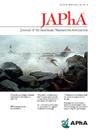Evaluation of an enhanced depression and anxiety screening with targeted pharmacist intervention
IF 2.5
4区 医学
Q3 PHARMACOLOGY & PHARMACY
Journal of the American Pharmacists Association
Pub Date : 2024-07-01
DOI:10.1016/j.japh.2024.102180
引用次数: 0
Abstract
Background
Depression is a major source of morbidity but often goes undiagnosed. Broader screening is recommended, and pharmacists could contribute.
Objectives
This study aimed to assess the feasibility of community pharmacy depression and anxiety screening and describe the medication-related problems (MRPs) identified, pharmacist interventions, and provider responses for high-risk patients.
Methods
This pilot was conducted between October 2022 and January 2023 at an independently owned community pharmacy in the Midwest United States. Patients aged 18-45 years with ready prescriptions were identified through weekly reports, and tags were placed on prescription bags. A convenience sample of patients fluent in English were offered the Patient Health Questionnaire (PHQ2) and Generalized Anxiety Disorder (GAD2), with follow-up PHQ9 and GAD7 for at-risk individuals. High-risk individuals met with the pharmacist for consultation and recommendations were discussed. Descriptive statistics were calculated for participant demographics, questionnaire responses, MRPs, and provider responses. Patient profiles were examined 2 months after the workup to identify medication changes.
Results
A total of 29 patients volunteered to be screened for anxiety and depression; of these, 41% scored in the high-risk category for depression or anxiety and met with the pharmacist for the consultation. The pharmacist identified multiple MRPs. The most common was the need for additional therapy and inadequate dosages. Patients were reluctant for the pharmacist to follow up with their prescriber and were unreachable for telephone follow-up. Profiles reviewed 2 months after assessment showed half of the at-risk patients had one or more mental health medication changes.
Conclusion
Community pharmacists may have a role in the screening and management of patient mental health, although there were challenges with screening uptake and follow-up. The pharmacist identified multiple MRPs for this high-risk group for which greater routine monitoring and follow-up may be beneficial. More work seems needed to engage both patients and prescribers.
通过有针对性的药剂师干预,对强化抑郁和焦虑筛查进行评估。
背景:抑郁症是发病率的主要来源,但往往得不到诊断。建议进行更广泛的筛查,药剂师可以为此做出贡献:本研究旨在评估社区药房抑郁和焦虑筛查的可行性,并描述所发现的药物相关问题(MRPs)、药剂师干预措施以及医疗服务提供者对高风险患者的应对措施:本试验于 2022 年 10 月至 2023 年 1 月在美国中西部一家独立经营的社区药房进行。通过每周报告确定了 18-45 岁的现成处方患者,并在处方袋上贴了标签。对英语流利的患者进行了方便抽样调查,向他们提供了患者健康问卷 (PHQ2) 和广泛性焦虑症 (GAD2),并对高危人群进行了 PHQ9 和 GAD7 的随访。高危人群与药剂师会面咨询并讨论建议。对参与者的人口统计学特征、问卷回答、MRP 和提供者的回答进行了描述性统计。检查工作结束 2 个月后,对患者资料进行检查,以确定用药变化:共有 29 名患者自愿接受了焦虑和抑郁筛查;其中 41% 的患者被评为抑郁或焦虑的高危人群,并与药剂师进行了会诊。药剂师确定了多项 MRP。最常见的是需要额外治疗和剂量不足。患者不愿意让药剂师与处方医生进行跟进,也无法通过电话进行跟进。在评估结束 2 个月后对患者的资料进行审查,结果显示半数高危患者更换了一种或多种精神疾病药物:结论:社区药剂师可以在筛查和管理患者心理健康方面发挥作用,尽管在筛查和随访方面存在挑战。药剂师为这一高风险群体确定了多个 MRP,加强常规监测和随访可能会对其有所帮助。看来还需要做更多的工作,让患者和处方医生都参与进来。
本文章由计算机程序翻译,如有差异,请以英文原文为准。
求助全文
约1分钟内获得全文
求助全文
来源期刊
CiteScore
3.30
自引率
14.30%
发文量
336
审稿时长
46 days
期刊介绍:
The Journal of the American Pharmacists Association is the official peer-reviewed journal of the American Pharmacists Association (APhA), providing information on pharmaceutical care, drug therapy, diseases and other health issues, trends in pharmacy practice and therapeutics, informed opinion, and original research. JAPhA publishes original research, reviews, experiences, and opinion articles that link science to contemporary pharmacy practice to improve patient care.

 求助内容:
求助内容: 应助结果提醒方式:
应助结果提醒方式:


